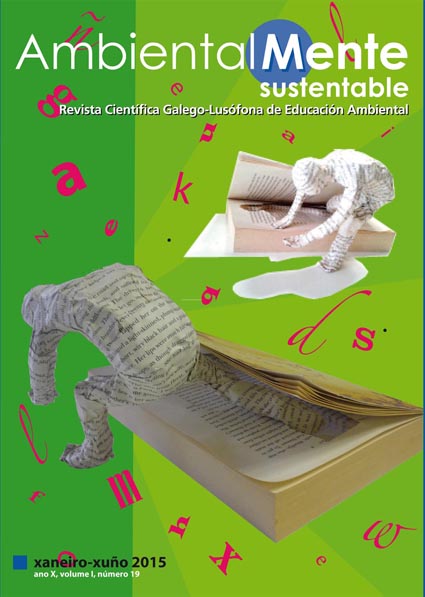Working with student teachers in education for sustainability: knowledge and biodiversity conservation
Main Article Content
Abstract
The present work describes an activity designed to integrate sustainability education topics in the initial training of Primary Education teachers, through the inclusion of the concept of biodiversity in the elaboration of works by specific projects. To promote and implement this methodology and the learning of this concept, his training focused on highlighting didactic strategies based on the construction of knowledge through a process of inquiry or oriented research; the values of communication present in the new instruments of scientific work also apply. These strategies lead to an understanding of the global nature of the concept and enable key decisions for action in the conservation of biodiversity.
Keywords:
Downloads
Article Details
References
Almeida, S.; Bombaugh, R.; MAL, T.K. (2006): “Involving School Children in the Establishment of a Long-Term Plant Biodiversity Study of an Urban Green Space”, en American Biology Teacher, 68 (4), 213-220.
Álvarez Lires, M.; Arias, A., Pérez Rodríguez, U., Serrallé, J. F. (2013): “La historia de las ciencias en el desarrollo de competencias científicas”, en Enseñanza de las Ciencias, 31 (1), pp. 213-233.
Anderson, R.D. (2007): Inquiry as an Organizing Theme for Science Curricula. In Abell, S.K. & Lederman, N.G. (2007). Handbook on Research on Science Education. New York: Routledge, pp.807-830.
Arias Correa, A.; Arias, D.; Navaza, M.V.; Rial, M.D. (2009): O traballo por proxectos en Infantil, Primaria e Secundaria. Santiago, Xunta de Galicia.
Bermudez, G.; De Longhi, A.; Díaz, S.; Gavidia, V. (2014): “La transposición del concepto de diversidad biológica. Un estudio sobre los libros de texto de la educación secundaria española”, en Enseñanza de las Ciencias, 32.3, pp. 285-302.
Bugallo Rodríguez, A. (2012): “GBIF de aula: Os novos instrumentos da investigación sobre biodiversidade na aula”, en I Simposio Internacional de Enseñanza de las Ciencias, Vigo, 11-16 de xuño de 2012.
Caamaño, A. (2014): “Indagar y modelizar en contextos”, en Alambique. Didáctica de las Ciencias Experimentales, nº 78, pp. 5-6.
Elliot, J. (1991): Environmental Education in Europe: Innovation, Marginalisation, or Assimilation, in Environment, Schools and Active Learning. París: OECD, pp. 19-36.
García Gómez, J.; Martínez Bernat, F.J. (2010): “Cómo y qué enseñar de la biodiversidad en la alfabetización científica”, en Enseñanza de las Ciencias, 28 (2), pp. 175-184.
Gayford, C. (2000): “Biodiversity Education: A Teacher’s Perspective”, en Environmental Education Research, 6 (4), 347-361.
Gillie, L. (1997): “Biodiversity Lab: Using Local Resources”, en Bioscene, 23 (2), pp. 6-7.
Gladstone, W.; Stanger, R.; Phelps, L. (2006): “A Participatory Approach to University Teaching about Partnerships for Biodiversity Conservation”, en Australian Journal of Environmental Education, 22 (2), 21-31.
González, E. (2002): “Educación ambiental para la biodiversidade: reflexiones sobre conceptos y prácticas”, en Tópicos en Educación Ambiental, 4 (11), 76-85.
González, E.; Vilches, A.; Gil Pérez, D.; Tricárico, H. (2010): “Educación para la ciudadanía: Un instrumento de educación para la sostenibilidad al servicio de los educadores”, en Congreso Iberoamericano de Educación. Metas 2020, Buenos Aires, 13-15 setembro 2010.
Ham, L.; Kelsey, E. (1998): Learning about Biodiversity: A First Look at the Theory and Practice of Biodiversity Education, Awareness and Training in Canada. Hull (Quebec), Enviroment Canada, Biodiversity Convention Office.
Haury, D. (1998): Teaching about Biodiversity. ERIC Digest. Washington, D.C. Office of Educational Research and Improvement. Report EDO-SE-98-15.
Hawkey, R. (2001): “Walking with Woodlice: An Experiment in Biodiversity Education”, en Journal of Biological Education, 36 (1), 11-15.
Hutchinson, T. (2001): Introduction to project work. Oxford, Oxford University Press.
Illinois Department Of Natural Resources (1999): “Illinois Biodiversity Basics”. Chicago Wilderness, World Wildlife Fund.
Jaen, M.; Esteve, P., Moreno, P.P. (2014): “Indagar sobre la pérdida de biodiversidad desde el consumo alimentario ciudadano”, en Alambique. Didáctica de las Ciencias Experimentales, n.º 78, pp. 43-50.
Lindemann-Matthies, P.; Constantinou, C.; Junge, X.; Kohler, K.; Mayer, J. et al. (2009): “The Integration of Biodiversity Education in the InitialEducation of Primary School Teachers: Four Comparative Case Studies from Europe”, en Environmental Education Research, 15(1), 17-37.
Mansell, M. (2010): “Biodiversity in School Grounds: Auditing, Monitoring and Managing an Action Plan”, en School Science Review, 91 (336), 89-98.
Menzel, S.; Bögeholz, S. (2010): “Values, beliefs and norms that Foster Chilean and German pupils’ commitment to protect biodiversity”, en International Journal of Environmental & Science Education, 5 (1), pp. 31-49.
Mogensen, F., Nielsen, K. (2001): “Students Knowledge about Environmental Matters and Their Belief in Own Action Posibilities -a Danish Study”, en The Journal of Environmental Education, 33, pp. 33-35.
Mogensen, F.; Mayer M. (2009): “Perspectivas sobre la educación ambiental. Un marco de trabajo crítico”. En Mogensen, F., Mayer, M., Breiting, S., Varga, A. Educación para el desarrollo sostenible. Barcelona: Ed. Graó.
Novo, M. (2009): “La educación ambiental, una genuina educación para el desarrollo sostenible”, en Revista de Educación, número extraordinario 2009, pp. 195-217.
Organización Das Nacións Unidas (2010): “Decenio das Nacións Unidas para a Biodiversidade Biolóxica 2011-2020. Metas de Aichi Nagoya-Xapón 2010”, en AmbientalMente Sustentable, ano IV, vol. 1, n.º 11-12, pp. 169-172.
Reimink, R. (1995): “Teach Biodiversity at the Bell”, en American Biology Teacher, 57 (2), pp. 106-107.
Schnack, K. (1998): “Why focus on Conflicting Interests in Environmental Education?”. En Ahlberg, M., Filho, W.L. (eds.). Environmental Education for Sustainability: Good Environment, Good Life. Frankfurt am Main, Peter Lang, Europäischer verlag der Wissenchaften, pp. 83-96.
Schnack, K. (2000): “Action Competence as a Curriculum Perspectiva”, en Jensen, B.B., Schnack, K., Simovska, V. (eds.). Critical environmental and Health Education-Research Issues and Challenges. Copenhagen, Danish University of Education, pp. 107-127.
Siegel, H. (1988): Educating Reason: Rationality Critical Thinking, and Education. New York, Routledge Inc.
World Wildlife Fund, Washington, DC. (1999): Windows on the Wild: Biodiversity Basics. An Educator’s Guide to Exploring the Web of Life [and] Student Book. Acorn Naturalists, Tustin, CA 92780.
World Wildlife Fund, Washington, Dc.; Wisconsin Center For Environmental Education, Stevens Point (1996): The Development of a Biodiversity Literacy Assessment Instrument. Report to the National Environmental Education Training Foundation. Washington, D.C., Eastman Kodak Co., Rochester, NY.; National Environmental Education and Training Foundation, Washington, DC.



